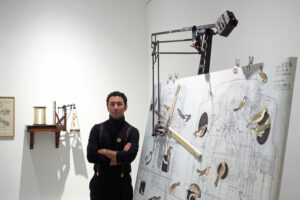How and why did you start your career in art?
From a young age, I was surrounded by artistic influence—my father was a calligrapher and craftsman. His ability to create intricate objects out of ordinary materials fascinated me and planted the seeds of creativity in me. Despite pursuing engineering academically, my passion for art was always present. During my engineering studies, I attended painting courses and focused on creating highly realistic works. After just one year, I became the assistant to my painting teacher in his workshop, which deepened my connection to the art world.
At the time, I was a master’s student in Process Design Engineering at the Vienna University of Technology. Professionally, my artistic career began when I passed the entrance exam for the Academy of Fine Arts Vienna. At that point, I made the significant and risky decision to leave engineering behind to fully dedicate myself to art. This shift was a turning point in my life—it was not just a change in career but a leap of faith to pursue my passion wholeheartedly. Moving from Tehran to Vienna and immersing myself in its vibrant arts scene was transformative, allowing me to fully develop my practice and embrace my artistic identity.
How did you discover your medium and why did you choose it?
I’ve always been captivated by objects that carry history—found items, antique blueprints, and architectural or industrial plans. My medium evolved naturally from this fascination. Working with these objects is my way of preserving and celebrating their beauty and history. By integrating them into my art, I aim to create a dialogue between the past and present, while also offering them a new narrative. To give these objects a new birth, I often opt for collage, assemblage, or installation. This approach bridges my technical background in engineering and my artistic sensibilities, making the medium deeply personal and meaningful.
Can you tell us about your creative process? How does your work come to life? How long does it take you to create a piece? When do you know it is finished?
My creative process often begins with discovery. I collect objects—sometimes for years—before their purpose in my work becomes clear. These objects guide the narrative, and I treat them with care, allowing their history and character to shine through. In recent years, it has also become part of my process to receive materials from others. Followers, fans, and collectors often generously provide me with items or exchange them for artworks of mine. For example, I’ve received antique plans from collectors who already have them in their archives and give them to me so I can give them a new life. In some cases, I return these transformed pieces after they are finished. This adds another layer to my practice, where materials sometimes find their way to me rather than me seeking them out.
My approach to creation is meticulous; I ensure that every element in my assemblages or collages complements the overall composition. The time it takes to complete a piece varies, but I rely on an intuitive sense to know when it feels complete. It’s a process of dialogue between myself and the materials, where I allow the piece to naturally reach its final form.
Who are your favorite artists? From whom do you draw inspiration?
I draw inspiration from a wide array of sources and artists. René Magritte and Max Ernst resonate with me for their ability to transform the ordinary into the extraordinary. Aby Warburg’s work, based on archives, deeply connects with my own approach to history and memory. I have tried to develop his practice in the collective I founded, RingelReih, where we work on projects mostly based on a sorted archive I’ve collected over the past 17 years.
I also admire the contemporary Austrian artist Markus Schinwald, particularly for the aesthetic of his works. My series As If They Always Belonged to Each Other reminds me of his works, although I wasn’t directly inspired by him. Interestingly, before seeing Schinwald’s pieces, I was already working in this way, and it was curators who introduced me to his art and pointed out the similarities in our approaches. This connection has made him one of my favorite artists.
Another artist I deeply admire is the German artist Anselm Kiefer. I’m particularly inspired by the way his studio is organized and how he categorizes and archives his materials. My own studio and carefully organized archive are like a small-scale version of Kiefer’s vast operation. I work in this direction and aspire to one day work on a similarly large scale, creating with the same level of ambition and structure.
From Italy, I am inspired by Alighiero Boetti. His conceptual approach and his ability to blend complexity with simplicity through repetitive patterns and intricate details resonate deeply with me. His exploration of order, chaos, and the collaborative nature of art reflects themes I also explore in my practice.
Alongside these figures, I draw inspiration from many anonymous creators whose works I discover in flea markets or archives. Their dedication to detail and craftsmanship deeply informs my practice and enriches my creative vision.








